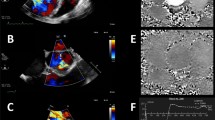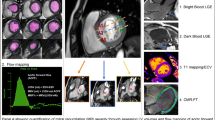Abstract
Objective
We aimed to evaluate the mitral valve calcification and mitral structure detected by cardiac computed tomography (cardiac CT) and establish a scoring model based on cardiac CT and clinical factors to predict early good mitral valve repair (EGMR) and guide surgical strategy in rheumatic mitral disease (RMD).
Materials and methods
This is a retrospective bi-center cohort study. Based on cardiac CT, mitral valve calcification and mitral structure in RMD were quantified and evaluated. The primary outcome was EGMR. A logical regression algorithm was applied to the scoring model.
Results
A total of 579 patients were enrolled in our study from January 1, 2019, to August 31, 2022. Of these, 443 had baseline cardiac CT scans of adequate quality. The calcification quality score, calcification and thinnest part of the anterior leaflet clean zone, and papillary muscle symmetry were the independent CT factors of EGMR. Coronary artery disease and pulmonary artery pressure were the independent clinical factors of EGMR. Based on the above six factors, a scoring model was established. Sensitivity = 95% and specificity = 95% were presented with a cutoff value of 0.85 and 0.30 respectively. The area under the receiver operating characteristic of external validation set was 0.84 (95% confidence interval [CI] 0.73–0.93).
Conclusions
Mitral valve repair is recommended when the scoring model value > 0.85 and mitral valve replacement is prior when the scoring model value < 0.30. This model could assist in guiding surgical strategies for RMD.
Clinical relevance statement
The model established in this study can serve as a reference indicator for surgical repair in rheumatic mitral valve disease.
Key Points
• Cardiac CT can reflect the mitral structure in detail, especially for valve calcification.
• A model based on cardiac CT and clinical factors for predicting early good mitral valve repair was established.
• The developed model can help cardiac surgeons formulate appropriate surgical strategies.
Graphical abstract






Similar content being viewed by others
Abbreviations
- ALCZ:
-
Anterior mitral leaflet clean zone
- Cardiac CT:
-
Cardiac computed tomography
- CI:
-
Confidence interval
- EGMR:
-
Early good mitral valve repair
- MPR:
-
Multiplanar reformation
- RMD:
-
Rheumatic mitral disease
References
Watkins DA, Johnson CO, Colquhoun SM et al (2017) Global, regional, and national burden of rheumatic heart disease, 1990–2015. N Engl J Med 377(8):713–722
Roth GA, Mensah GA, Johnson CO et al (2020) Global burden of cardiovascular diseases and risk factors, 1990–2019: update from the GBD 2019 study. J Am Coll Cardiol 76(25):2982–3021
Vahanian A, Beyersdorf F, Praz F et al (2022) 2021 ESC/EACTS Guidelines for the management of valvular heart disease. Eur Heart J 43(7):561–632
Fu J, Li Y, Zhang H et al (2021) Outcomes of mitral valve repair compared with replacement for patients with rheumatic heart disease. J Thorac Cardiovasc Surg 162(1):72-82.e7
Bernal JM, Pontón A, Diaz B et al (2010) Combined mitral and tricuspid valve repair in rheumatic valve disease: fewer reoperations with prosthetic ring annuloplasty. Circulation 121(17):1934–1940
Eleid MF, Foley TA, Said SM, Pislaru SV, Rihal CS (2016) Severe mitral annular calcification: multimodality imaging for therapeutic strategies and interventions. JACC Cardiovasc Imaging 9(11):1318–1337
Malik SB, Chen N, Parker RA 3rd, Hsu JY (2017) Transthoracic echocardiography: pitfalls and limitations as delineated at cardiac CT and MR imaging. Radiographics 37(2):383–406
Brescia AA, Watt TMF, Murray SL et al (2022) Rheumatic mitral valve repair or replacement in the valve-in-valve era. J Thorac Cardiovasc Surg 163(2):591-602.e1
Kim WK, Kim HJ, Kim JB et al (2018) Clinical outcomes in 1731 patients undergoing mitral valve surgery for rheumatic valve disease. Heart 104(10):841–848
Williams MC, Massera D, Moss AJ et al (2021) Prevalence and clinical implications of valvular calcification on coronary computed tomography angiography. Eur Heart J Cardiovasc Imaging 22(3):262–270
Weir-McCall JR, Blanke P, Naoum C, Delgado V, Bax JJ, Leipsic J (2018) Mitral valve imaging with CT: relationship with transcatheter mitral valve interventions. Radiology 288(3):638–655
Morris MF, Maleszewski JJ, Suri RM et al (2010) CT and MR imaging of the mitral valve: radiologic-pathologic correlation. Radiographics 30(6):1603–1620
Massera D, Trivieri MG, Andrews JPM et al (2019) Disease activity in mitral annular calcification. Circ Cardiovasc Imaging. 12(2):e008513
Agatston AS, Janowitz WR, Hildner FJ, Zusmer NR, Viamonte M Jr, Detrano R (1990) Quantification of coronary artery calcium using ultrafast computed tomography. J Am Coll Cardiol. 15(4):827–832
Cruz-Gonzalez I, Sanchez-Ledesma M, Sanchez PL et al (2009) Predicting success and long-term outcomes of percutaneous mitral valvuloplasty: a multifactorial score. Am J Med 122(6):581.e11–9
Bouleti C, Iung B, Himbert D et al (2013) Reinterventions after percutaneous mitral commissurotomy during long-term follow-up, up to 20 years: the role of repeat percutaneous mitral commissurotomy. Eur Heart J 34(25):1923–1930
Dreyfus J, Cimadevilla C, Nguyen V et al (2014) Feasibility of percutaneous mitral commissurotomy in patients with commissural mitral valve calcification. Eur Heart J 35(24):1617–1623
DiBardino DJ, ElBardissi AW, McClure RS, Razo-Vasquez OA, Kelly NE, Cohn LH (2010) Four decades of experience with mitral valve repair: analysis of differential indications, technical evolution, and long-term outcome. J Thorac Cardiovasc Surg 139(1):76–83
Yakub MA, Dillon J, Krishna Moorthy PS, Pau KK, Nordin MN (2013) Is rheumatic aetiology a predictor of poor outcome in the current era of mitral valve repair? Contemporary long-term results of mitral valve repair in rheumatic heart disease. Eur J Cardiothorac Surg 44(4):673–681
Tamirat S, Mazine A, Stevens LM et al (2021) Contemporary outcomes of aortic and mitral valve surgery for rheumatic heart disease in sub-Saharan Africa. J Thorac Cardiovasc Surg 162(6):1714-1725.e2
Chen SW, Chen CY, Chien-Chia WuV et al (2022) Mitral valve repair versus replacement in patients with rheumatic heart disease. J Thorac Cardiovasc Surg 164(1):57-67.e11
El Oumeiri B, Boodhwani M, Glineur D et al (2009) Extending the scope of mitral valve repair in rheumatic disease. Ann Thorac Surg. 87(6):1735–1740
Dillon J, Yakub MA, Kong PK, Ramli MF, Jaffar N, Gaffar IF (2015) Comparative long-term results of mitral valve repair in adults with chronic rheumatic disease and degenerative disease: is repair for “burnt-out” rheumatic disease still inferior to repair for degenerative disease in the current era? J Thorac Cardiovasc Surg 149(3):771–777
Singh A, Steadman CD, McCann GP (2014) Advances in the understanding of the pathophysiology and management of aortic stenosis: role of novel imaging techniques. Can J Cardiol 30(9):994–1003
Simard L, Côté N, Dagenais F et al (2017) Sex-related discordance between aortic valve calcification and hemodynamic severity of aortic stenosis: is valvular fibrosis the explanation? Circ Res 120(4):681–691
Tomšič A, Hiemstra YL, van Brakel TJ et al (2019) Outcomes of valve repair for degenerative disease in patients with mitral annular calcification. Ann Thorac Surg 107(4):1195–1201
Abramowitz Y, Jilaihawi H, Chakravarty T, Mack MJ, Makkar RR (2015) Mitral annulus calcification. J Am Coll Cardiol 66(17):1934–1941
Al-Taweel A, Almahmoud MF, Khairandish Y, Ahmad M (2019) Degenerative mitral valve stenosis: diagnosis and management. Echocardiography 36(10):1901–1909
Uçar O, Vural M, Cetfïn Z et al (2011) Assessment of planimetric mitral valve area using 16-row multidetector computed tomography in patients with rheumatic mitral stenosis. J Heart Valve Dis 20(1):13–17
Bouleti C, Iung B, Himbert D et al (2014) Relationship between valve calcification and long-term results of percutaneous mitral commissurotomy for rheumatic mitral stenosis. Circ Cardiovasc Interv 7(3):381-389.r
Chang S, Kim H, Suh YJ et al (2021) Development of a deep learning-based algorithm for the automatic detection and quantification of aortic valve calcium. Eur J Radiol 137:109582
Brodov Y, Konen E, Di Segni M et al (2019) Mitral annulus calcium score. Circ Cardiovasc Imaging 12:e007508
Katchi F, Bhatt D, Markowitz SM et al (2019) Impact of aortomitral continuity calcification on need for permanent pacemaker after transcatheter aortic valve replacement. Circ Cardiovasc Imaging 12:e009570
d’Alessandro C, Vistarini N, Aubert S et al (2007) Mitral annulus calcification: determinants of repair feasibility, early and late surgical outcome. Eur J Cardiothorac Surg 32(4):596–603
Guerrero M, Wang DD, Pursnani A et al (2020) A cardiac computed tomography-based score to categorize mitral annular calcification severity and predict valve embolization. JACC Cardiovasc Imaging 13(9):1945–1957
Luo T, Han J, Meng X (2017) Features of rheumatic mitral valves and a grading system to identify suitable repair cases in China. J Thorac Dis 9(9):3138–3147
Dillon J, Yakub MA, Nordin MN, Pau KK, Krishna Moorthy PS (2013) Leaflet extension in rheumatic mitral valve reconstruction. Eur J Cardiothorac Surg 44(4):682–689
Kim JB, Kim HJ, Moon DH et al (2010) Long-term outcomes after surgery for rheumatic mitral valve disease: valve repair versus mechanical valve replacement. Eur J Cardiothorac Surg 37(5):1039–1046
Hutchison SJ, Tak T, Mummaneni M et al (1995) Morphological characteristics of the regurgitant rheumatic mitral valve. Can J Cardiol 11(9):765–769
Goldstein D, Moskowitz AJ, Gelijns AC et al (2016) Two-year outcomes of surgical treatment of severe ischemic mitral regurgitation. N Engl J Med 374(4):344–353
Koulaouzidis G, Nicoll R, MacArthur T, Jenkins PJ, Henein MY (2013) Coronary artery calcification correlates with the presence and severity of valve calcification. Int J Cardiol 168(6):5263–5266
Acknowledgements
We thank LetPub (www.letpub.com) for its linguistic assistance during the preparation of this manuscript.
The data that support the findings of this study are available from the RDR database (http://118.26.69.165:23023/RDR/login.html), but restrictions apply to the availability of these data, which were used under license for the current study, and so are not publicly available. Data are, however, available from the authors upon reasonable request and with permission.
Funding
This study has received funding by grants from the National Natural Science Foundation of China (82170487, U1908211, 82271986), the 2022 China Association for Science and Technology Think Tank Youth Talent Plan (KCZD202203), the Capital’s Funds for Health Improvement and Research Foundation of China (2020-1-1052), and major scientific and technological innovation research and development project of Beijing Anzhen Hospital affiliated to Capital Medical University and High-End Foreign Experts Introduction Plan (G2022001039L).
Author information
Authors and Affiliations
Corresponding authors
Ethics declarations
Guarantor
The scientific guarantor of this publication is Dr. Wenjian Jiang.
Conflict of interest
The authors of this manuscript declare no relationships with any companies, whose products or services may be related to the subject matter of the article.
Statistics and biometry
Dr. Jing Liu has significant statistical expertise and kindly provided statistical advice for this manuscript.
Informed consent
Written informed consent was waived by the Institutional Review Board.
Ethical approval
Institutional Review Board approval was obtained. Our research program was approved by the Ethics Committee of Beijing Anzhen Hospital (KS2022078), and the privacy and personally identifiable information of the subjects were protected; therefore, the requirement for informed consent was waived. Clinical registration number: ChiCTR2200067151.
Study subjects or cohorts overlap
No study subjects or cohorts have been previously reported before.
Methodology
• retrospective
• diagnostic or prognostic study
• multicenter study, performed at two institutions
Additional information
Publisher's Note
Springer Nature remains neutral with regard to jurisdictional claims in published maps and institutional affiliations.
Supplementary Information
Below is the link to the electronic supplementary material.
Rights and permissions
Springer Nature or its licensor (e.g. a society or other partner) holds exclusive rights to this article under a publishing agreement with the author(s) or other rightsholder(s); author self-archiving of the accepted manuscript version of this article is solely governed by the terms of such publishing agreement and applicable law.
About this article
Cite this article
Wang, M., Zhang, H., Liu, Z. et al. Scoring model based on cardiac CT and clinical factors to predict early good mitral valve repair in rheumatic mitral disease. Eur Radiol (2024). https://doi.org/10.1007/s00330-023-10470-0
Received:
Revised:
Accepted:
Published:
DOI: https://doi.org/10.1007/s00330-023-10470-0




